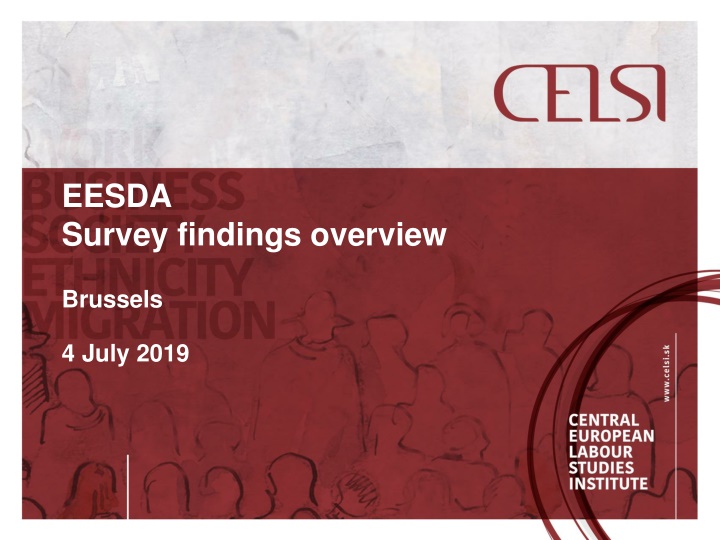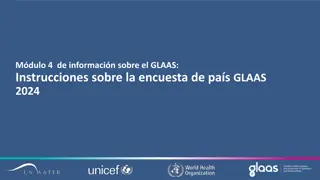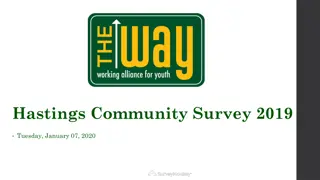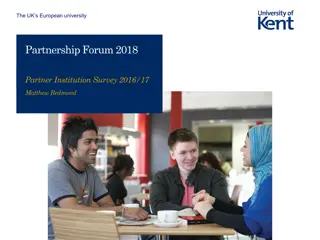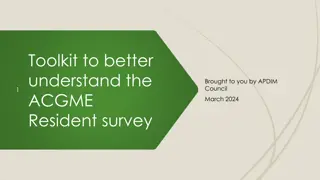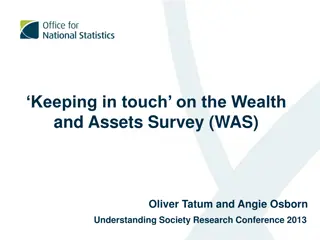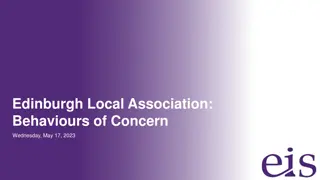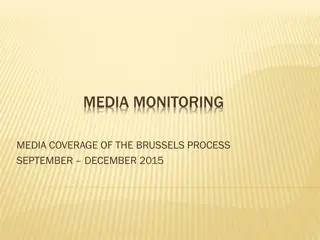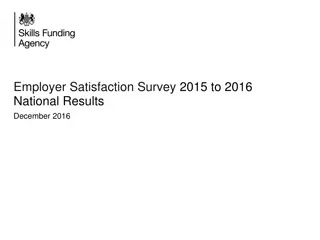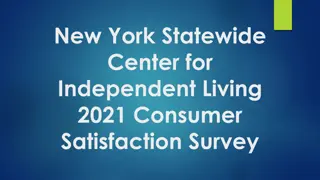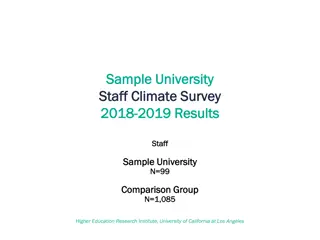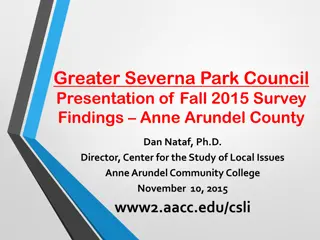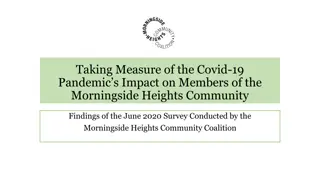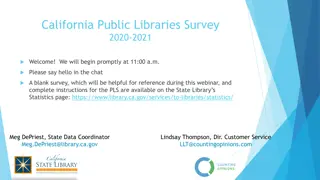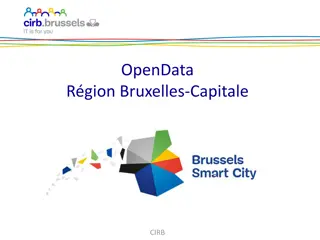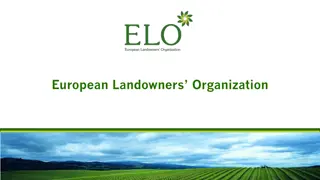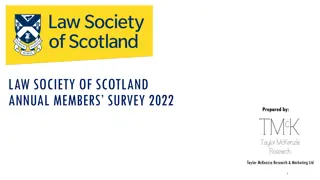EESDA Survey Findings Overview in Brussels July 2019
The EESDA survey findings overview in Brussels in July 2019 included data from survey implementation over 6 months in November 2018 to April 2019. It analyzed responses from 28 EU member states, focusing on the structure of responses and respondents per organization type. The survey also delved into responses by IR clusters, highlighting different national industrial relations systems. Moreover, selected survey results shed light on the dynamics of social dialogue articulation and the effectiveness of bottom-up engagement among trade unions and employers. The findings provide insights into EU-level social dialogue participation and associated challenges.
Download Presentation

Please find below an Image/Link to download the presentation.
The content on the website is provided AS IS for your information and personal use only. It may not be sold, licensed, or shared on other websites without obtaining consent from the author.If you encounter any issues during the download, it is possible that the publisher has removed the file from their server.
You are allowed to download the files provided on this website for personal or commercial use, subject to the condition that they are used lawfully. All files are the property of their respective owners.
The content on the website is provided AS IS for your information and personal use only. It may not be sold, licensed, or shared on other websites without obtaining consent from the author.
E N D
Presentation Transcript
EESDA Survey findings overview Brussels 4 July 2019
Survey implementation 6 months, November 2018 April 2019 28 EU member states 147 responses in total 130 responses used in the analysis Structure of responses: - 12 other 6 classified rather as EOs, 2 as TUs, 4 as national level policy makers Respondents per organisation type Other 12 9% Trade Union 68 52% Employers association/fede ration 50 39% Trade Union Other Employers association/federation
Survey responses by IR clusters National industrial relations systems Organized corporatis m (Nordic) Liberal pluralism (West) State- centred (Southern) Social partnershi p (Central- West) Embedded neoliberal (Central- East) Neoliberal (North- East, South- East) DK (4), FI (6), SE(5) CY (2), IE (3), MT (9), UK (N/A) ES (5), FR (4), EL (0), IT (3), PT(6) AT(2), BE(3), DE(6), LU(2), NL(4), SI(4) CZ(7), HR(6), HU(5), PL(5), SK(10) BG(5), EE(9), LV(8), LT(5), RO(2) Countries 15 14 18 21 33 29 Number of responses
Selected survey results Most dynamic articulation takes place along sectoral lines: most respondents involved in EU-level SD via an EU-level sectoral organization Second most important form of involvement in EU-level SD structures: Ecosoc Involvement in the European Semester never exclusive, always with combination with other channels of involvement 57 respondents indicated their organizations is not participating in EU level SD - most frequent reason: lack of financial resources and capacity constraints; thus organizational barriers (lack of organizational resources) for ESD involvement while procedural transparency is not perceived frequently as a reason for non- participation
Selected survey results Effectiveness of bottom-up social dialogue articulation: similar perception by TUs and EOs that they do have opportunities to initiate discussions; however, TUs (51%) perceived more opportunities in articulating topics of own suggestion than employers (38%). TUs use bottom-up articulation mostly in sectoral SD committees while employers in ECOSOC meetings Form of discussion: most exchange, but more than 50% of all proposals seem to lead to binding or (=effectiveness of SD) common is information non-binding agreement
Selected survey results preference for a type of outcome depends on relational factors actors ability to implement outcomes (= effective SD articulation) two extremes: depending on the topic discussed, a binding outcome (Directive) serves as additional institutional resource that actors prefer; but at the same time they emphasize the feasibility of non-binding outcomes Highlight the information exchange role of SD and actors preference for maintaining flexibility in top-down SD articulation. Puzzle: TUs from new member states consider non-binding outcomes suitable but at the same time in their answers they called for more binding outcomes
Selected survey results Improvements policy recommendations In the implementation-follow up procedures In a better alignment of the agenda of various EU-level committees In the way the agenda of national social dialogue in our country is transposed to the agenda of EU-level social dialogue In the way EU-level agenda is transposed to social dialogue agenda in our country In the type of outputs of social dialogue (social dialogue should lead to different kinds of binding or non-binding outputs than in currently does In the depth of social dialogue, more negotiation instead of only information exchange In the relationships between organizations/participants within the committees In the agenda that we discuss in the committees In the structure of who participates in EU-level social dialogue committees 0.00% 10.00% 20.00% 30.00% 40.00% 50.00% 60.00%
Slovakia: research progress Interview code Organization Type Tripartism Function respondent participates in EU-level SD meetings vicepresident NAT1 NAT2 KOZ SR KOZ SR Asociacia priemys.zvazov APZ Trade union Trade union yes yes NAT3 Employers' association yes generalny sekretar Ecosoc member on behalf of AZZZ NAT4 AZZZ Employers' association yes manager for social dialogue, deputy general secretary of AZZZ Business Europe member NAT5 NAT6 AZZZ RUZ SR Employers' association Employers' association yes yes podpisala obe aktualne KZVS pre statnu a verejnu spravu dec 2018 vykonni podpredseda ZMOS NAT7 NKOS Trade union no NAT8 ZMOS Municipalities/employers yes Head of HSR, State secretary MPSVR NAT9 Ministry of Labor Government yes Centrum SD II, Implementa n agent ra MPSVR NAT10 Ministry of Labor Government cross- sectoral Government yes NAT11 Government yes Coordinator of HSR
Slovakia: research progress Sectoral interviews: in progress, 2 done, 16 to come August-September Survey data analysis for Slovakia only in the context of other Visegrad countries (more in-depth picture on countries with a similar industrial relations background and stronger cooperation ties as shown in the network analysis (may be relevant for other regions as well, cross-check the findings of Carl s network analysis with survey findings on particular country clusters) Lunch seminar in early November Webinar prepared before the final conference
First thoughts comparative report Evaluation of SD effectiveness and SD articulation effectiveness across several IR clusters (institutional resources, data from national and sectoral evidence) Evaluation of SD effectiveness and SD articulation based on organization resources (survey data) Evaluation of SD effectiveness and SD articulation related to structural resources (sector-specific data) Comparing the desired SD outcomes, challenges, weaknesses by type of actors and type of IR systems Evaluation of SD effectiveness by sectors and an attempt to understand why SD in some sectors works better than in others (leadership/org capacities or something else?) Cross-check the findings across various levels of analysis: how do the perceptions of EU-level social partners meet perceptions of national social partners? How does network analysis complement the survey and country findings?
Webinar topics Each partner to deliver 1 webinar in English Topics for webinars: EU-level SD effectiveness, perceived effectiveness of SD processes and SD articulation by national stakeholders (survey data) Comparison of topics covered in EU-level, sectoral and national SD fora Perceived benefits and challenges in top-down and bottom-up articulation of SD A network perspective on the functioning of SD in the EU Sectoral perspectives on SD articulation (comparison of public vs. private sectors, production vs. services)
Thank you for your attention! marta.kahancova@celsi.sk
